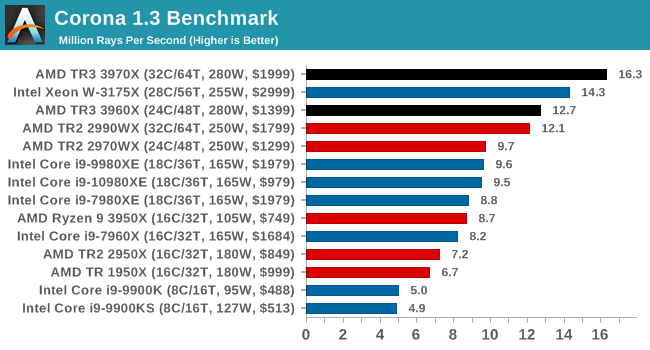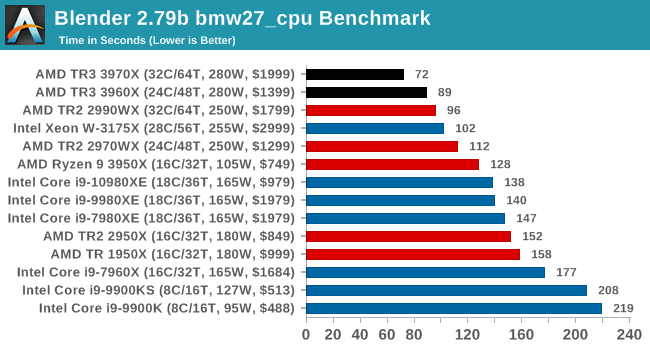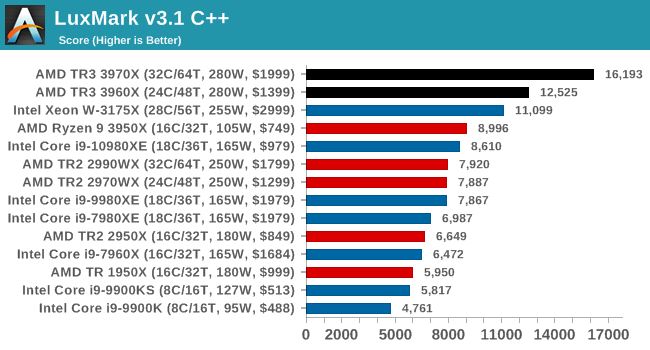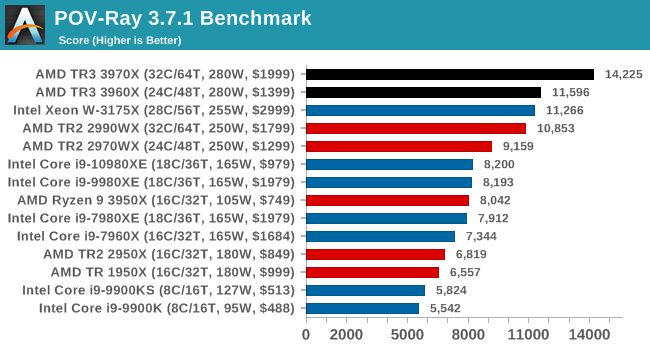The AMD Ryzen Threadripper 3960X and 3970X Review: 24 and 32 Cores on 7nm
by Dr. Ian Cutress, Andrei Frumusanu & Gavin Bonshor on November 25, 2019 9:05 AM ESTCPU Performance: Rendering Tests
Rendering is often a key target for processor workloads, lending itself to a professional environment. It comes in different formats as well, from 3D rendering through rasterization, such as games, or by ray tracing, and invokes the ability of the software to manage meshes, textures, collisions, aliasing, physics (in animations), and discarding unnecessary work. Most renderers offer CPU code paths, while a few use GPUs and select environments use FPGAs or dedicated ASICs. For big studios however, CPUs are still the hardware of choice.
All of our benchmark results can also be found in our benchmark engine, Bench.
Corona 1.3: Performance Render
An advanced performance based renderer for software such as 3ds Max and Cinema 4D, the Corona benchmark renders a generated scene as a standard under its 1.3 software version. Normally the GUI implementation of the benchmark shows the scene being built, and allows the user to upload the result as a ‘time to complete’.
We got in contact with the developer who gave us a command line version of the benchmark that does a direct output of results. Rather than reporting time, we report the average number of rays per second across six runs, as the performance scaling of a result per unit time is typically visually easier to understand.
The Corona benchmark website can be found at https://corona-renderer.com/benchmark

Being fully multithreaded, we see the order here follow core counts. That is except for the 32-core 2990WX sitting behind the 24-core 3960X, which goes to show how much extra performance is in the new TR generation.
Blender 2.79b: 3D Creation Suite
A high profile rendering tool, Blender is open-source allowing for massive amounts of configurability, and is used by a number of high-profile animation studios worldwide. The organization recently released a Blender benchmark package, a couple of weeks after we had narrowed our Blender test for our new suite, however their test can take over an hour. For our results, we run one of the sub-tests in that suite through the command line - a standard ‘bmw27’ scene in CPU only mode, and measure the time to complete the render.
Blender can be downloaded at https://www.blender.org/download/

We have new Threadripper records, with the 3970X almost getting to a minute to compute. Intel's nearest takes almost as long, but does only cost half as much. Again, the 3960X puts the 2990WX in its place.
LuxMark v3.1: LuxRender via Different Code Paths
As stated at the top, there are many different ways to process rendering data: CPU, GPU, Accelerator, and others. On top of that, there are many frameworks and APIs in which to program, depending on how the software will be used. LuxMark, a benchmark developed using the LuxRender engine, offers several different scenes and APIs.
In our test, we run the simple ‘Ball’ scene. This scene starts with a rough render and slowly improves the quality over two minutes, giving a final result in what is essentially an average ‘kilorays per second’.

Our LuxMark test again pushes both TR3 processors out in the lead.
POV-Ray 3.7.1: Ray Tracing
The Persistence of Vision ray tracing engine is another well-known benchmarking tool, which was in a state of relative hibernation until AMD released its Zen processors, to which suddenly both Intel and AMD were submitting code to the main branch of the open source project. For our test, we use the built-in benchmark for all-cores, called from the command line.
POV-Ray can be downloaded from http://www.povray.org/

More rendering, more wins for AMD. More losses for the 2990WX, even though on these tests it still beats the 10980XE quite easily.











245 Comments
View All Comments
darwi - Monday, November 25, 2019 - link
certainly 60 PCIe4 lanes is best than 48 PCIe3.since SLI is not next best thing for the moment this is quite enough for the most currents setup.
But filling up all those 48 PCIe could be possible with mulitiple storage+network and GPU.
However my main point is that the 10980Xe doing an "ok job" and for some users a 500$ or 1k$ bill is a steep step to jump to the first step of the TR4 lineup.
on the other hand the CM Chipset / Socket instability is a major pain point belonging to intel so far
We will see since Milan is the last iteration of this architecture family before a major architecture revision which certainly require a new socket (according to published roadmaps)
the TR4
blppt - Monday, November 25, 2019 - link
I shouldnt have to keep posting this, but your 7980XE Geekbench MT score is highly inaccurate.I don't overclock anything, and i get 52,000+ consistently.
You either have completely disabled turbo or have some other problem that prevents the cpu from going higher than 2.6 base, because 31K is pathetic.
https://browser.geekbench.com/v4/cpu/14797740
Korguz - Monday, November 25, 2019 - link
blppt is geekbench even reliable ? a quick search.. seems to point in the direction, that it isnt.blppt - Tuesday, November 26, 2019 - link
What difference does it make whether or not GB4 is 'reliable'? They shouldn't be getting such ridiculously low scores for the 7980XE/9980XE, which means that there is something wrong with their configuration.Especially since literally every other cpu result in their chart is within the margins for what everybody else gets in GB4.
Slash3 - Tuesday, November 26, 2019 - link
It may have to do with their memory speed and timings. Reviews specify that the platforms are tested at JEDEC timings for each platform, but have never (to my knowledge) listed the specific subtimings used. For X299, this could easily mean from 2666 CL17-17-17 up to 2666 CL20-20-20. If you're running at, say, 3200 CL14-14-14 it may account for at least some of the difference.blppt - Tuesday, November 26, 2019 - link
Nope. 2666, you can see in the link I provided. Secondly, ram speed would not come close to making up a 20,000 point deficit. Something is wrong with their 18-core Intel setup.prime2515103 - Monday, November 25, 2019 - link
Lisa Sue is my hero. When the day comes that she leaves AMD I am going to cry like a little girl.prime2515103 - Monday, November 25, 2019 - link
oops... Su... lolpeevee - Tuesday, November 26, 2019 - link
She gave Zen architecture to Chinese. Why would she do that, when AMD could have sold them the CPUs? Gaving our the most precious IP you have? Sounds like treason.yeeeeman - Monday, November 25, 2019 - link
I like a these Steven Spielberg type of users commenting here about the cataclysm that is striking Intel. Intel is doomed. Intel doesn't know anything. Intel is this, Intel is that. Intel has only one weakness now, its Fab. Otherwise, we can't know if chiplets were included in their plans for 10 or 7nm. We don't know yet what uarch they have in the pipeline. We see that ice lake is already a better core than zen 2. Probably Zen 3 will close the gap in ipc. Tiger lake brings another 10%. So Intel has responses. But they need to fix their Fab issue...